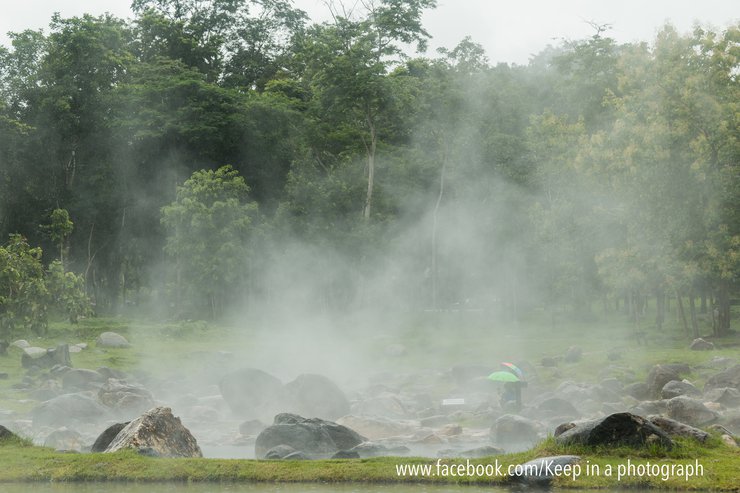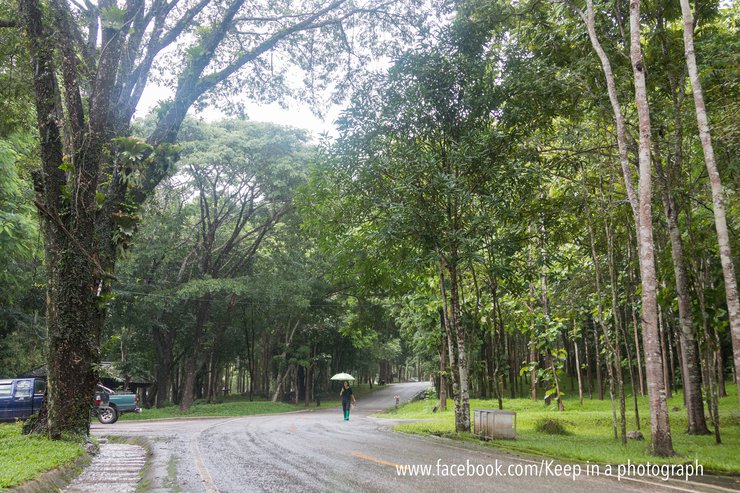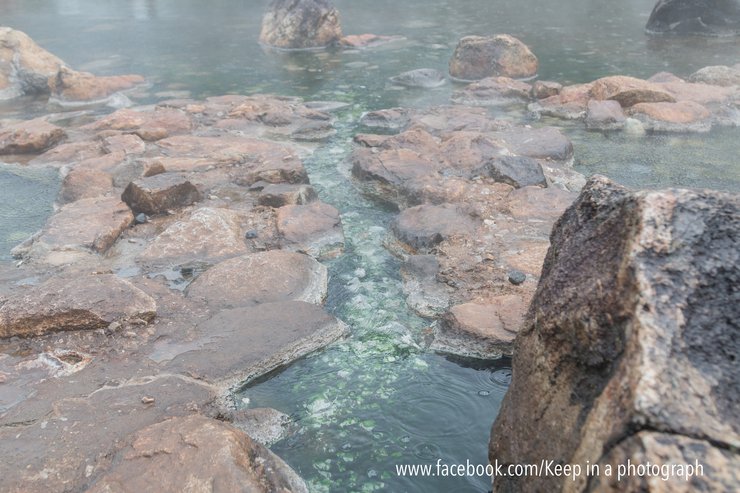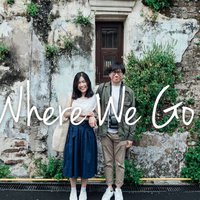"Lampang," a city brimming with charm, boasts ancient Lanna-style temples and monasteries alongside a slow-paced lifestyle. From leisurely horse-drawn carriage rides to serene riverside restaurants, Lampang offers a tranquil escape. Renowned for its exquisite ceramics, the city captivates visitors with its unique allure. Immerse yourself in the slow life and discover the magic of Lampang, a place that lingers in your memory long after your visit.
"Follow other photos at^^
Page >> https://www.facebook.com/keepinaphotograph
Instagram>> https://www.instagram.com/au.keepinaphotograph
Our journey began at 9:30 AM by car from Chiang Mai Province. We took the route through San Kamphaeng District and entered Huay Kaew Road, passing Mae Kampong Village and Pa Hemiyong Village. Our first destination was "Chae Son National Park".


The drive was accompanied by persistent rain, forcing us to proceed cautiously due to ongoing road construction in certain sections. We arrived at the park close to noon and decided to have lunch at the park's restaurant. The air was exceptionally fresh, likely due to the recent rainfall, which had revitalized the surroundings.



After lunch, we went to take pictures at the Jae Sawn Hot Spring. The first thing we did when we arrived was to "boil eggs" in the hot spring. It was a unique experience. After leaving the park, we continued our journey to Lampang city to check in to our accommodation.



We booked a room at "The Pring Cafe' & Hostel" located on Kong Ta Walking Street. The room rate was 600 baht per night. It is an old building (called Fong Lee Building). The staff was friendly and the room was decorated nicely. After we checked in, our next destination was "Lampang Railway Station".



The train station is approximately 3 kilometers from the accommodation, which is another landmark of Lampang city.

We took some photos as souvenirs and then had lunch at a roast duck restaurant near the train station.



After lunch, we drove to the Old City Hall, which is a horse-drawn carriage stop. We took a horse-drawn carriage ride around Lampang for 300 baht per round (depending on the distance). The ride took about 20-30 minutes. The horse-drawn carriage took us slowly through the important points in the city. After the ride, we asked the uncle who drove the horse-drawn carriage if he had any restaurant recommendations. He told us about a restaurant on the Wang River called "Chailai." So we went to eat there.



Upon arrival, we were not disappointed. The atmosphere was great, and the food was delicious. We sat until 9 pm before returning to our accommodation.
::Day 2::
We woke up early to take a walk and enjoy the atmosphere of the old town from our accommodation to the "Rattanakosin Bridge or White Bridge," which is a symbol of Lampang city.





On our way back, we stopped by "Noodle Dumpling Magong Da" restaurant. It's a classic-style noodle shop that gives you a nostalgic feeling like being a child again. The noodles are also delicious.^^



After lunch, we drove to admire the beauty of the Buddha Gaya Pagoda at Wat Jong Kham. We drove a distance of 71 km and arrived at Wat Jong Kham.




The Buddhist stupa at Bodh Gaya is located behind the temple and can be accessed by car. The stupa is significant as a place to commemorate the Buddha's enlightenment. The interior of the stupa is adorned with beautiful Buddha statues in various postures surrounding the ubosot. After paying respects and making offerings, we drove back to the city.





The next stop is a visit to "Baan Sao Nak", a century-old traditional Thai teak house with 116 pillars, true to its name ("Baan Sao Nak" means "house of many pillars"). The interior is decorated with antique items. The entrance fee is 50 baht per person. Visitors are allowed to explore all areas of the house. After taking photos, the grandmother of the house prepared water and snacks for us and chatted with us in a friendly manner. We didn't spend much time there because we had to move on to the "Thanabodee Museum".

Known for its renowned ceramics and pottery, Lampang is a must-visit destination. The entrance fee is 60 baht per person.

The Thana Bodin Ceramic Museum, a unique landmark and the birthplace of Lamphun's famed rooster bowls, houses valuable historical artifacts. These include ancient dragon kilns, miniature rooster-emblazoned bowls, and gold-emblazoned rooster bowls. The museum also features exhibitions showcasing the origins of rooster bowls, highlighting their artistic and cultural significance in local life.








Moreover, we have the opportunity to paint our own unique bowl designs (a one-of-a-kind piece of art!).

For painting, there are two types of paint to choose from: watercolor and oil paint. We chose oil paint because it can be picked up within half an hour, while watercolor requires several days of drying time. The shop will then send it to our home by post. After finishing the painting, it was 5 pm, just in time to go for a walk at the Kad Kong Ta Walking Street.



The walking street was packed today, with most vendors selling souvenirs and plenty of food options.^^ However, the rain started shortly after we began walking, causing the market to close earlier than usual.
::Day 3::
After checking out, we went back to Makongta Restaurant for another round of delicious noodles.^^ We then set off for "Phra Bat Pu Pha Daeng Temple," which was about 60 kilometers away.

Upon arrival at the temple's first-floor parking lot, visitors must park their vehicles and take the temple's shuttle service to the second-floor parking lot due to the steep and winding road (ticket price: 100฿ per person).

The summit is approximately 1 kilometer uphill from here. It is recommended to bring water as there are no vendors at the top.




Along the way to the top of the mountain, there are viewpoints to stop and admire the beautiful scenery. Looking down, you can see the panoramic view of Muang Pan district, houses, and rice fields as far as the eye can see. We walked leisurely, taking photos as we went, and soon reached the summit.



The view from above is breathtaking. You can see steep cliffs, a golden pagoda on the highest peak, and many white pagodas scattered around the mountain.


After paying our respects and making offerings at the temple, we descended to continue our journey to the "Phra That Lampang Luang" temple.

Upon our arrival at the temple, we encountered a Kathin ceremony in progress. This festive occasion resulted in an unusually high number of people present at the temple.




"Wat Phra That Lampang Luang" is an ancient temple that has been a symbol of Lampang for centuries. It is also one of the most well-preserved wooden temples in Thailand. After we paid our respects to the Buddha and admired the beauty of the temple, we headed back.
::::Thank you to everyone who followed our journey and photos.◡̈ See you again on our next trip!::::
we journey
Tuesday, October 8, 2024 11:25 AM






















